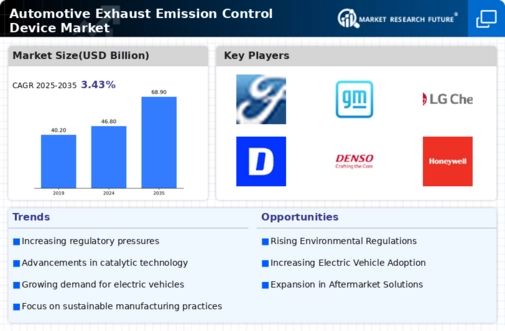Top Industry Leaders in the Automotive Exhaust Emission Control Device Market
*Disclaimer: List of key companies in no particular order
Top listed global companies in the Automotive Exhaust Emission Control Device industry are:
Denso Corporation (Japan), Johnson Matthey (UK), Continental Emitech Gmbh (Germany), Bosal (Belgium), CDTi Advanced (California), Eberspächer (Germany), Bosch Rexroth (Germany), Tenneco Inc. (USA), Albonair GmbH (Germany), and Faurecia (France).
Bridging the Gap by Exploring the Competitive Landscape of the Automotive Exhaust Emission Control Device Top Players
The automotive exhaust emission control device market is a crucial cog in the machine driving towards cleaner air and environmental sustainability. With stringent emission regulations tightening globally, this market is set for steady growth. Navigating this dynamic landscape requires a keen understanding of the competitive strategies employed by key players, emerging trends, and factors impacting market share analysis.
Key Player Strategies:
- Global Giants: Established players like Johnson Matthey, Faurecia, Denso, and Tenneco leverage their deep technological expertise, extensive research and development (R&D) capabilities, and strong supplier relationships with major automakers to maintain their market dominance. These players focus on strategic acquisitions, partnerships, and product diversification to cater to different emission control needs across various vehicle types and engine technologies.
- Regional Contenders: Regional players like Albonair, Bosal, and Eberspächer carve out niches by specializing in specific technologies or catering to local market demands. They offer cost-competitive solutions and often collaborate with global players to gain access to broader markets and technological advancements.
- Emerging Startups: Innovative startups are entering the fray, focusing on cutting-edge technologies like advanced catalysts, lightweight materials, and sensor-based control systems. They disrupt the market by offering highly efficient and cost-effective solutions, sometimes partnering with established players to overcome resource limitations and scale their operations.
Factors for Market Share Analysis:
- Technology Portfolio: The breadth and depth of a company's technology portfolio, encompassing different emission control devices (catalytic converters, particulate filters, selective catalytic reduction systems, etc.) and catering to diverse vehicle types, plays a crucial role in market share.
- R&D Focus: Continuous investment in R&D to develop more efficient, cost-effective, and environmentally friendly emission control technologies is vital for sustained competitive advantage.
- Geographical Presence: A strong global presence with manufacturing facilities and distribution networks in key regions like Asia-Pacific, Europe, and North America allows players to capitalize on regional growth opportunities and cater to diverse emission regulations.
- Cost Competitiveness: Offering cost-effective solutions without compromising on efficiency is essential for gaining market share, particularly in price-sensitive regions.
- Strategic Partnerships: Building strategic partnerships with automakers, material suppliers, and research institutions facilitates knowledge sharing, technology development, and market access, boosting a company's competitive edge.
New and Emerging Trends:
- Electrification: The rise of electric vehicles (EVs) poses a challenge for traditional emission control device manufacturers. However, opportunities exist in developing emissions control systems for hybrid vehicles and tackling non-tailpipe emissions from EVs.
- Lightweight Materials: The focus on fuel efficiency is driving demand for lightweight emission control devices made from advanced materials like ceramics and metals, reducing vehicle weight and emissions.
- Smart Emission Control Systems: Integration of sensors and advanced control systems into emission control devices is gaining traction, allowing for real-time monitoring, optimization, and adaptive performance adjustments.
- Circular Economy: Implementing sustainable practices like recycling precious metals from used catalysts and remanufacturing components aligns with environmental regulations and fosters a positive brand image.
Overall Competitive Scenario:
The automotive exhaust emission control device market is characterized by intense competition. While established players hold a significant share, regional players and innovative startups are chipping away at the market through specialization, cost-effectiveness, and disruptive technologies. The landscape is further dynamic due to the evolving regulatory landscape, technological advancements, and the burgeoning EV market. Success in this environment hinges on adaptability, continuous innovation, a focus on cost-effectiveness, and strategic partnerships. Companies that can navigate these trends and cater to the evolving needs of automakers and regulators will be well-positioned to capture a larger share of this ever-growing market.
Latest Company Updates:
Denso Corporation (Japan):
- October 2023: Announced a new high-performance three-way catalyst for gasoline engines, achieving lower emissions and improved fuel efficiency. (Source: Denso press release)
Johnson Matthey (UK):
- December 2023: Partnered with FAW Group to develop and supply emission control catalysts for heavy-duty trucks in China. (Source: Johnson Matthey press release)
Bosal (Belgium):
- October 2023: Acquired Tenneco's Clean Air business unit, expanding its emission control product portfolio. (Source: Bosal press release)
CDTi Advanced (California):
- November 2023: Announced a partnership with a major trucking company to pilot test its emissions reduction technology. (Source: CDTi website)
Eberspächer (Germany):
- September 2023: Launched a new exhaust gas recirculation (EGR) system for gasoline engines, reducing CO2 emissions. (Source: Eberspächer press release)









